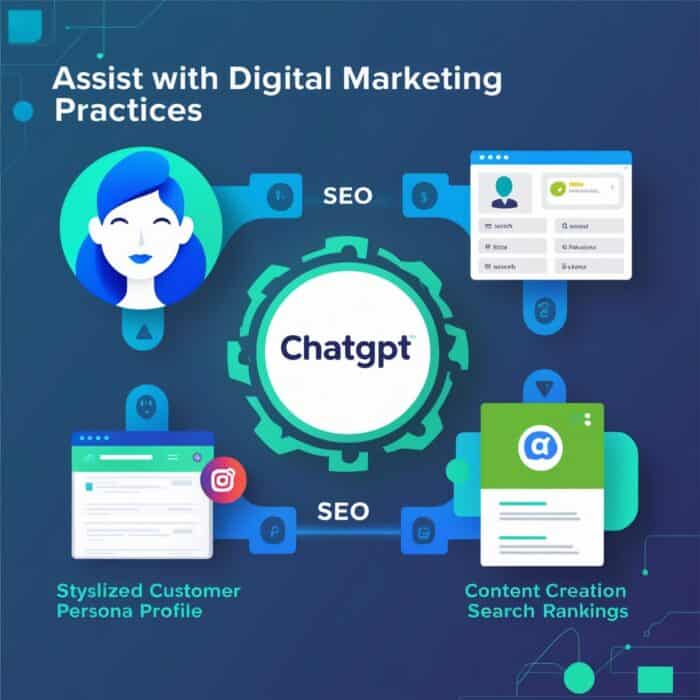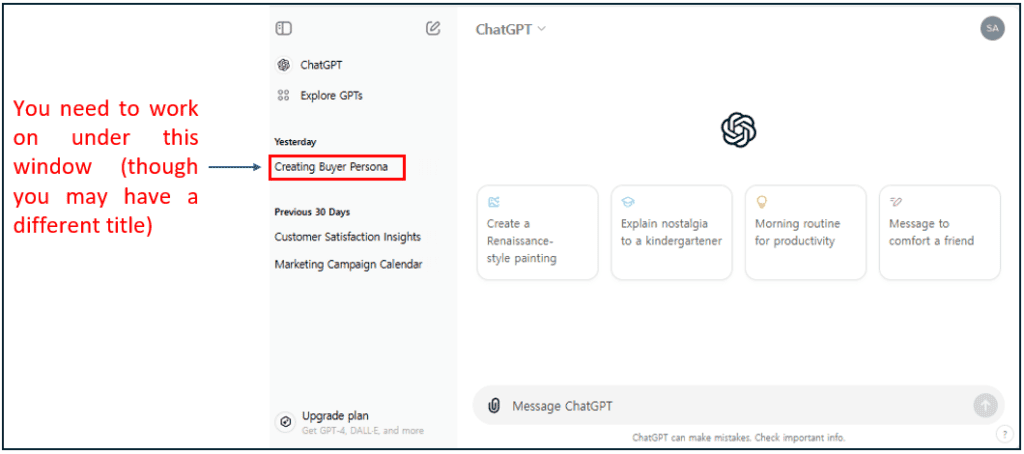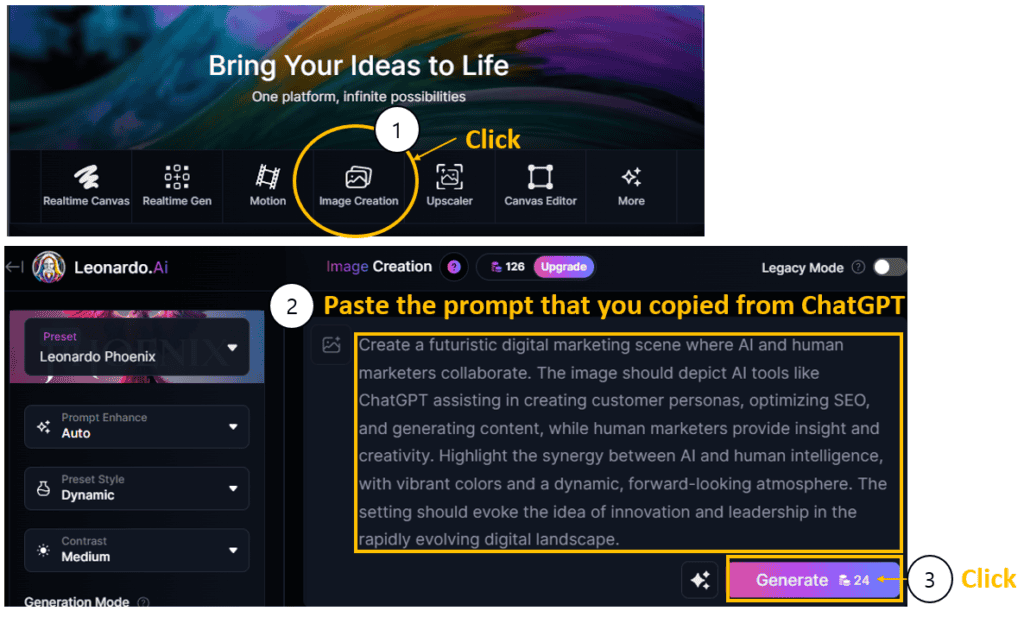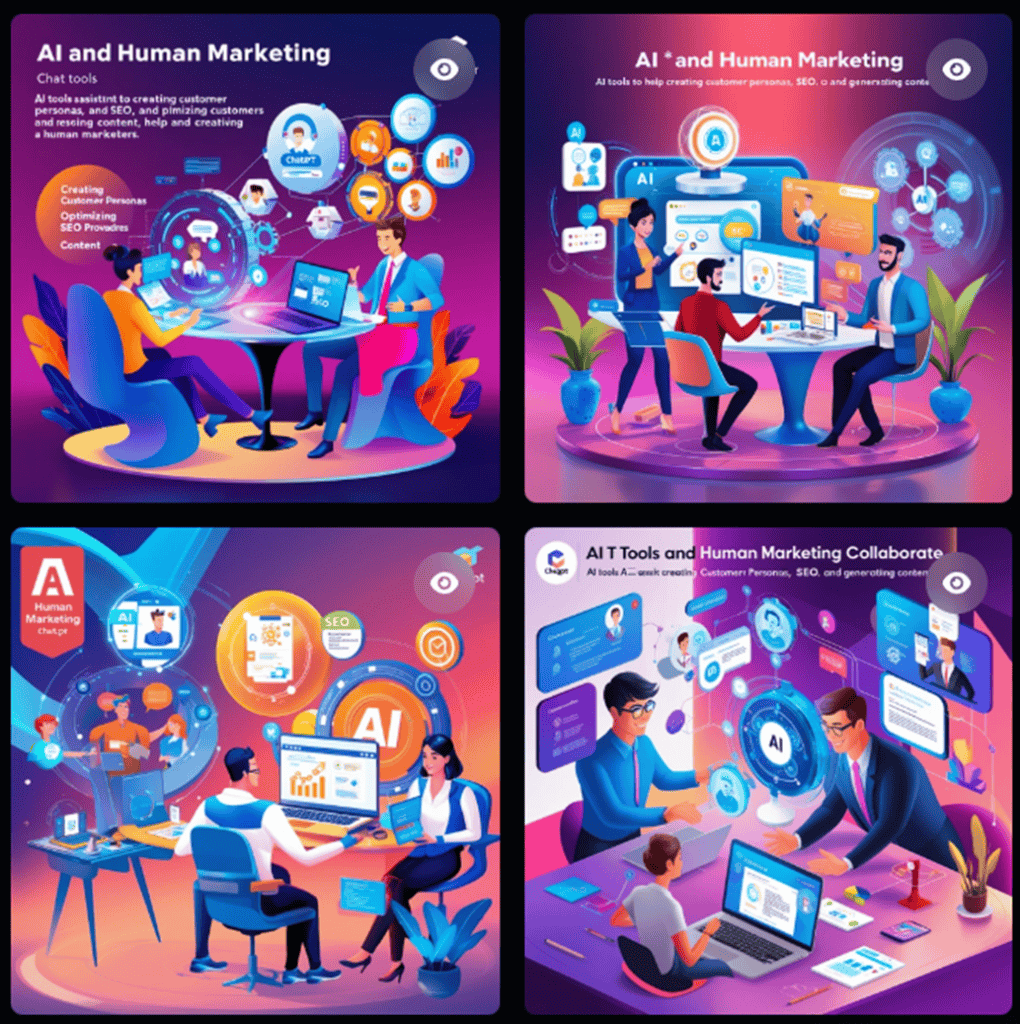
ChatGPT and digital marketing practice: Customer persona, Search engine optimization (SEO), and content creation.
You will learn how ChatGPT can contribute to the marketing process. Now it’s time for you to use ChatGPT to perform various marketing tasks yourself. You will learn various prompts for ChatGPT that can increase efficiency. Go ahead and give it a try.
Setting up your account at ChatGPT
Please go to ChatGPT (https://chatgpt.com) and set up your account. It won’t take a minute.

Customer Persona
As you have learned, a customer persona is the starting point for marketing strategies. The good news is ChatGPT can help you create one, but it needs the basic information. Actually, no one knows your customers better than you do. You can obtain such information from your sales data or marketing research.
Information needed:
Let’s ask ChatGPT what information it needs. You can simply input a prompt into a chatbox as you can see below.
Prompt: I want to create a customer persona. What information do you need to create it?

Then, ChatGPT will give you an answer similar to that below. To save space, all ChatGPT outputs will be condensed by showing only the beginning and end portions of each output, omitting the middle sections.

Then, provide as much information as you have though you may not answer everything. Just do your best. Then it will ask you follow-up questions.
**
In this case, I will use well-organized customer data. As universities upload fact sheets about their student body, I will take advantage of them. As I used Black Hills State University as a case, I will go to its homepage and simply download the file (https://www.bhsu.edu/about-bhsu/BHSU_FACT_SHEET.pdf). Then, I will upload the file and enter a proper prompt in the chatbox.

Prompt: OK, here I upload a file regarding the student body profile at Black Hills State University. Based on the file, try to infer all the information you need to create a customer persona (i.e., a promising new student persona). Then, also list the information you think is still needed.
**
Then ChatGPT asks you for further information.

Unprovidable information:
The best scenario is that you can answer all the questions, but you may not be able to. Don’t worry. ChatGPT itself can give you answers based on general information it has collected. I will ask ChatGPT to execute this task by giving question items I could not answer. I will use the following prompt.
Prompt: Regarding the following items, we don’t have detailed information. Based on all the general information available to you, guess what they might be like:
Specific Interests & Hobbies: Details about what prospective students enjoy outside of academics (e.g., sports, arts, clubs).
Personality Traits: Are they more academically driven, socially active, or career-focused?
Detailed Online Behavior: Which social media platforms do they prefer? How do they search for and interact with educational institutions online?
Family Background: Information about parental education levels and involvement in the decision-making process.
Financial Background: More granular details about family income levels and financial concerns.
Career Aspirations: Specific job roles or industries they aspire to work in after graduation
Then, ChatGPT can generate its own answers.

Generating customer persona
It’s time to generate a customer persona based on the information collected. I will input the following prompt into the chatbox
Prompt: Now, you seem to have all the information to create a customer persona. Using the information in our conversation, create a customer persona (i.e., a promising new student persona).
Then, you can see a nice customer persona!!

With these steps, you can have your customer persona. Based on this customer persona, you can work on various marketing-related tasks.
*** Important: As long as you keep working on the same chat window regarding a customer persona, ChatGPT will give you answers based on it. The conversation will be saved on ChatGPT and you can find the chat on the window on the left side.

Search engine optimization (SEO)
You have learned how to do keyword research with the help of free tools. Those tools are great in that they provide metrics. While such detailed metrics may not be available through ChatGPT, it can still provide you with useful keywords.
Keyword research
Let’s say you want to know the top keywords that people most commonly use to find information about Black Hills State University. I will use the following prompt.
Prompt: Make a list of the top 5 keywords people use to find information about Black Hill State University on Google. Separated by comma
Then, ChatGPT gives the following answer.

Compare the keywords you identified from the free tools with these findings.
Content creation
Now you have a customer persona, so ChatGPT can provide content ideas that the customer persona would love. The prompts used for content creation are modified versions of those created by Diego Davila (ChatGPT Marketing: Create Complete Campaigns w/ Chat GPT AI | Udemy)
Blog post idea.
Let’s get ChatGPT to provide useful blog post idea using the following prompt (You can change the words underlined for your case).
Prompt: Write 10 blog post ideas about Black Hills State University that the customer persona created earlier is searching for.
Boom! You got it!

Writing a blog post.
Now you have blog post ideas and can choose a few of them. Let’s say you pick an idea: “Why Choose BHSU? 10 Reasons to Make It Your University Home”. While we’re at it, why don’t we have ChatGPT write a blog post too? Alright, let’s do it right now! Let’s enter the followong prompt (You can change the words underlined for your case).
Prompt: I want you to act as a blogger with expertise at Black Hills State University. You are writing a blog post for “Why Choose BHSU? 10 Reasons to Make It Your University Home“. This post should be helpful for people learning about Black Hills State University.
There should be a call to action at the end of each section. The length of the blog post will be 1000 to 2500 words. The tone will be informal.
You should write as an individual blogger with a personal approach so do not use plural first-person to refer to yourself. Eg. “our”, or “we”. Only use singular first-person. Do not use passive voice.
Here is the outcome. This is a total game-changer! Seeing AI write so naturally, it feels like the future is already here.

Social media posts
Now you have a blog post about the topic. What about creating social media posts? For example, Instagram. Let’s put the prompt into the chatbox.
Prompt: Create an Instagram post regarding “Why Choose BHSU? 10 Reasons to Make It Your University Home” for this customer persona.
There you go!

Image creation
ChatGPT is a great tool, but does not create an image directly. However, it can write you a prompt that you can use at free text-based image tools. It means you can create a high-quality image by combining ChatGPT and free image tools.
Here, we will use Leonardo.AI. Go to the website and create your account.

Then, return to ChatGPT again and ask ChatGPT to create a prompt. Here, I will ask ChatGPT to write a prompt to create an image that describes a certain text.
Prompt: I am going to draw a picture regarding the text below using an AI image generator. Write a proper prompt – Today, we’ve seen how AI can revolutionize marketing strategies. ChatGPT has shown its potential in creating customer personas, optimizing SEO, and generating content. Remember, these tools are here to enhance our creativity, not replace it. The future of marketing lies in the collaboration between human insight and AI capabilities. Your challenge is to harness this potential and innovate. With these tools at your disposal, you’re ready to lead in the rapidly evolving digital landscape.
ChatGPT gives you a prompt to generate a relevant image that you can copy.

It’s time to generate an image. Go to Leonardo.AI and follow the steps below

Now you have four images that you can download!

One last word
Today, we’ve seen how AI can revolutionize marketing strategies. ChatGPT has shown its potential in creating customer personas, optimizing SEO, and generating content. Remember, these tools are here to enhance our creativity, not replace it. The future of marketing lies in the collaboration between human insight and AI capabilities. Your challenge is to harness this potential and innovate. With these tools at your disposal, you’re ready to lead in the rapidly evolving digital landscape.
